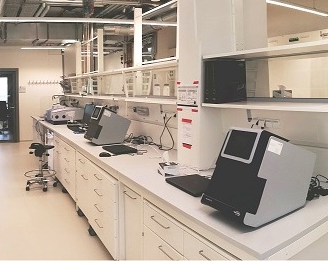View All Molecular Biophysics at Instruct
The Molecular Biophysics platform at EMBL Hamburg offers one of the most-well equipped biophysical laboratories in Europe. We support users with the design, execution and data analysis of biophysical experiments aimed at the characterization of proteins, protein complexes and interactions between proteins and other types of molecules.
Spark provides unparalleled wavelength accuracy, with a dedicated highspeed monochromator for absorbance measurements. Together with a cuvette port and the patented NanoQuant Plate, it provides an all-in-one solution for ELISAs, low volume DNA/protein quantification and fast spectral scanning.
Octet RED96 system is a multi-functional, label-free, real-time analysis instrument. It is ideal for rapidly measuring concentration of proteins and other biomolecules, measuring kinetics and affinity, and screening protein-protein and protein-small molecule interactions. The Octet RED96 system provides reliable kinetics information including kobs, ka, kd, KD for protein-biomolecule interactions all the way down to protein-small molecule interactions.
Measures the hydrodynamic radius (RH) and size distribution profile of molecules in solution, specifically measures time-dependent fluctuations in the scattering intensity coming from particles undergoing random Brownian motion. Diffusion coefficient and particle size information can be obtained from the analysis of these fluctuations.
ITC is a thermodynamic technique that directly measures the heat released or absorbed during a biomolecular binding event. The technique allows simultaneous determination of all binding parameters in a single experiment ITC (n, K, ∆H and ΔS). It directly measures sub-millimolar to nanomolar binding constants.
Microscale Thermophoresis Monolith LabelFree allows measurement of interactions between all types of biomolecules. Broad application range from ions to ribosomes and for pM to mM binding affinities. Besides the dissociation constant, MST datasets contain unique information about aggregation and sample quality. It utilizes the intrinsic tryptophan fluorescence, real label-free and immobilization-free experiments and reflects binding of the protein in its native state.
Microscale Thermophoresis Monolith NT.115 measures the motion of molecules along microscopic temperature gradients and detects changes in their hydration shell, charge or size. By combining the precision of fluorescence detection with the flexibility and sensitivity of thermophoresis, MST provides a flexible, robust and fast way to measure molecular interactions via a fluorescent dye or protein.
SPC offers services packages for molecular dynamics simulations and data analysis on biomolecular interactions experiments done in our core facility.
In nanoDSF, a protein in solution is exposed to a temperature gradient that will lead to the unfolding of the protein. The intrinsic fluorescence of the protein, mainly originating from the aromatic side-chains of tyrosine and tryptophan residues, is examined. Upon unfolding, the environment of those residues will alter because they become exposed to the solvent and thus, their fluorescence intensity will change. The relation between fluorescence intensity changes and temperature gradient can be used to obtain a so-called apparent melting temperature (Tm). Also, information can be gained indicating cooperative (two-state) or complex unfolding transitions in multi-domain proteins.A common application of nanoDSF is the determination of the conformational stability of proteins.
Microcal PEAQ-ITC is a highly sensitive, low volume isothermal titration calorimeter for the label-free in solution study of biomolecular interactions. It delivers direct measurement of all binding parameters in a single experiment and can analyze weak to high affinity binders, using as little as 10µg sample.
Mass photometry is a revolutionary new way to analyze molecules. It enables the accurate mass measurement of single molecules in solution, in their native state and without the need for labels. Some benefits of mass photometry involves: Accurate mass measurement of true native behavior (in solution, in a variety of buffers as being label-free, without the need to modify samples), information on all sub-populations in samples: single molecule counting, wide mass range and high dynamic range. One assay format can deliver a lot of information: homogeneity, structural integrity and activity through a quick, simple measurement, with minimal sample amounts required.
Determination of protein secondary structure, binding studies involving conformational changes and denaturing studies on proteins or biological molecules.
Typically used to gain an understanding of reaction mechanisms including drug-binding processes, or to determine protein structure, stopped-flow spectroscopy enables the study of fast reactions in solution over timescales in the range of 1 millisecond to hundreds of seconds. A wide range of reactions can be investigated involving, for example, protein-protein interactions, ligand binding, electron transfer, fluorescence resonance energy transfer (FRET), protein folding, as well as enzyme, chemical or coordination reactions. A series of stopped-flow experiments can be used to show the effect of parameters such as temperature, pH and reagent concentration on the kinetics of a reaction.
Rubic, Additive screens or any custom screen can be run to optimize the homogeneity, stability and solubility of a specific protein sample.
Our molecular biophysical platform at EMBL Hamburg consist of a pipeline of several techniques to target biological questions concerning macromolecular assemblies and their intrinsic properties. The characterisation of these structures are studied by studying parameters such as stability, shape, folding state, aggregation tendency, homogeneity and oligomeric states. The interactions in which they are involved can be followed by measuring biophysical criteria like; specificity, kinetics, affinity, and thermodynamics.
For more details regarding our biophysical technology platform, please visit us at:
http://www.embl-hamburg.de/services/spc/Services-and-resources/Sample-Characterization/index.html
https://www.cssb-hamburg.de/facilities/pc/index_eng.html





